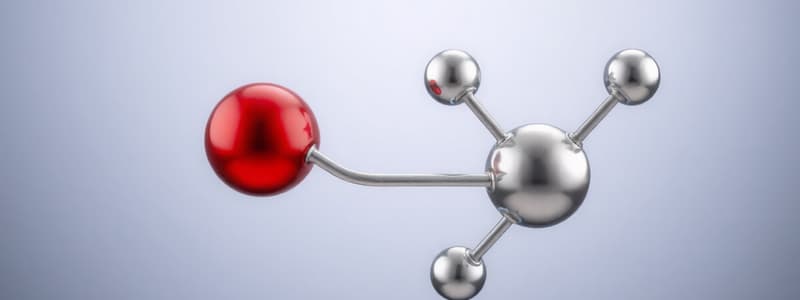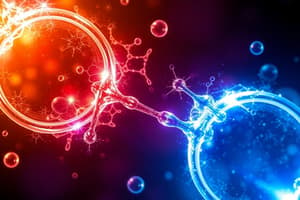Podcast
Questions and Answers
What is the definition of ionic bonding?
What is the definition of ionic bonding?
Electrostatic force of attraction between oppositely charged ions formed by electron transfer.
What factors affect the strength of ionic bonding?
What factors affect the strength of ionic bonding?
The size of the ions and the magnitude of their charges.
Ionic compounds have high melting points.
Ionic compounds have high melting points.
True (A)
Ionic compounds are generally good conductors of electricity in solid state.
Ionic compounds are generally good conductors of electricity in solid state.
Explain why positive ions are smaller than their corresponding neutral atoms.
Explain why positive ions are smaller than their corresponding neutral atoms.
Explain why negative ions are larger than their corresponding neutral atoms.
Explain why negative ions are larger than their corresponding neutral atoms.
What is the effect of the size of the ionic radii on the strength of ionic bonding?
What is the effect of the size of the ionic radii on the strength of ionic bonding?
What is metallic bonding?
What is metallic bonding?
What are the three main factors that affect the strength of metallic bonding?
What are the three main factors that affect the strength of metallic bonding?
Metals are good conductors of electricity.
Metals are good conductors of electricity.
Metals are malleable and ductile.
Metals are malleable and ductile.
What is covalent bonding?
What is covalent bonding?
What are the two types of covalent bonding?
What are the two types of covalent bonding?
What type of forces hold simple molecules together in a solid or liquid state?
What type of forces hold simple molecules together in a solid or liquid state?
Covalent compounds generally have low boiling and melting points.
Covalent compounds generally have low boiling and melting points.
What is a dative covalent bond?
What is a dative covalent bond?
What is the difference between a simple covalent bond and a dative covalent bond?
What is the difference between a simple covalent bond and a dative covalent bond?
What is the shape of a carbon atom in a diamond?
What is the shape of a carbon atom in a diamond?
Diamond is a very hard substance.
Diamond is a very hard substance.
What is the structure of graphite?
What is the structure of graphite?
Graphite can conduct electricity.
Graphite can conduct electricity.
What is activation energy?
What is activation energy?
What is the Maxwell Boltzmann distribution?
What is the Maxwell Boltzmann distribution?
The Maxwell Boltzmann distribution shows that the total area under the curve should remain constant because the total number of particles is constant.
The Maxwell Boltzmann distribution shows that the total area under the curve should remain constant because the total number of particles is constant.
What is rate of reaction?
What is rate of reaction?
Rate of reaction is an approximation for the rate of reaction as it does not include concentration.
Rate of reaction is an approximation for the rate of reaction as it does not include concentration.
What are van der Waals forces?
What are van der Waals forces?
What is the main factor affecting the size of van der Waals forces?
What is the main factor affecting the size of van der Waals forces?
Van der Waals forces occur between all molecular substances and noble gases.
Van der Waals forces occur between all molecular substances and noble gases.
What is hydrogen bonding?
What is hydrogen bonding?
Hydrogen bonding is a type of dipole-dipole interaction.
Hydrogen bonding is a type of dipole-dipole interaction.
What are permanent dipole-dipole forces?
What are permanent dipole-dipole forces?
Permanent dipoles can occur in molecules with only non-polar covalent bonds.
Permanent dipoles can occur in molecules with only non-polar covalent bonds.
What does electronegativity refer to?
What does electronegativity refer to?
Electronegativity generally increases down a group in the periodic table.
Electronegativity generally increases down a group in the periodic table.
What is a non-polar molecule?
What is a non-polar molecule?
Non-polar molecules generally have low boiling and melting points.
Non-polar molecules generally have low boiling and melting points.
Flashcards are hidden until you start studying
Study Notes
Ionic Bonding
- Formed by electrostatic attraction between oppositely charged ions formed by electron transfer.
- Giant lattices of ions have stronger structures and higher melting points when the ions are smaller and/or have higher charges.
- Positive ions are smaller than the corresponding neutral atom because they have lost an electron shell, leading to a greater ratio of protons to electrons, hence a stronger force on remaining electrons.
- Negative ions are larger than the corresponding neutral atom because they have gained more electrons than protons.
- Ions do not conduct electricity in the solid state but do so when molten.
Metallic Bonding
- Electrostatic force of attraction between positive metal ions and delocalised electrons.
- Metals are shiny and malleable because positive ions in a lattice are identical and layers of ions can slide easily.
- Delocalised electrons can move, preventing fragmentation and allowing good conductivity.
- The strength of metallic bonding depends on the number of protons, the number of delocalised electrons, and the size of the ions.
Covalent Bonding
- Strong electrostatic attraction between the negative shared pair of electrons and the positive nuclei of the bonded atoms.
- Covalent compounds can form molecules.
- Low boiling and melting points due to similar electronegativity of the constituent elements.
- Generally poorly soluble in water as a gas or liquid.
- Dative covalent bonds are a type of covalent bond where both electrons in the shared pair originate from the same atom.
Giant Covalent Structures
- High boiling and melting points due to strong covalent bonds.
- Macromolecular structure.
- Localisation of electrons in the bonds prevents electrical conductivity.
- Generally insoluble in water, solids.
- Examples: Diamond (tetrahedral arrangement, 4 covalent bonds per atom) and graphite (planar arrangement, 3 covalent bonds per atom, with delocalised electrons, which allows conductivity).
Maxwell-Boltzmann Distribution
- The distribution of energies among particles in a sample of matter.
- The mean energy of the particles is not at the peak of the curve.
- The area under the curve represents the total number of particles.
- Most molecules have energies between the two extremes but the distribution is not symmetrical.
- Energy (Eₐ) is required for particles to successfully collide and start a reaction.
Rate of Reaction
- Change in concentration of a substance in unit time.
- An approximation of the rate of reaction as it doesn't include concentration.
Van der Waals' Forces
- Transient, induced dipole-dipole interactions caused by fluctuating electron density in molecules.
- The number of electrons in a molecule affects the strength of Van der Waals' forces.
- Long chain alkanes have a higher surface area for intermolecular contact which lead to stronger Van der Waals' than branched alkanes.
- Occur between all molecular substances and noble gases.
- Not in ionic substances.
Hydrogen Bonding
- Compounds with hydrogen atoms attached to highly electronegative atoms (N, O, F) with lone pairs of electrons.
- Large electronegativity differences create a strong dipole between the hydrogen atom and the more electronegative atom.
- Hydrogen bonding is stronger than other intermolecular forces, impacting boiling and melting points.
Permanent Dipole-Dipole Forces
- Covalent bonds with elements of different electronegativity creating a charge separation in the bond resulting in permanent dipoles.
- The molecules interact because the positive end of one molecule and the negative end of the other molecule attract.
- Dipoles in symmetrical shapes cancel making the molecule non-polar, while asymmetrical ones are polar.
Electronegativity
- Relative tendency of an atom in a covalent bond to attract electrons towards itself.
- Electronegativity Trends: Increases across a period, decreases down a group.
- F, O, N, and Cl are the most electronegative elements.
- Affected by the distance between the nucleus and the outer electrons, the shielding of inner electron shells and the number of protons in the nucleus. Atomic radius also influences electronegativity.
Studying That Suits You
Use AI to generate personalized quizzes and flashcards to suit your learning preferences.




